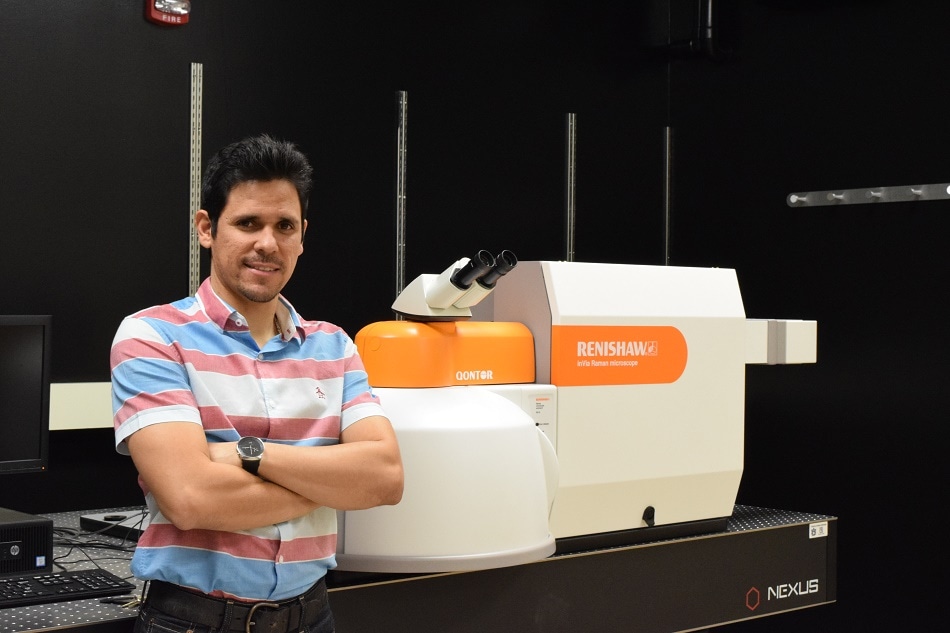Renishaw inVia™ microscope user, Prof. Carlos A. Carrero, heads a group that is developing advanced catalysts for the conversion of hydrocarbons into more valuable products at the Department of Chemical Engineering, Auburn University, USA.
 Prof. Carlos A. Carrero with his Renishaw inVia™ Qontor® confocal Raman microscope
Prof. Carlos A. Carrero with his Renishaw inVia™ Qontor® confocal Raman microscope
The Carrero group undertakes fundamental studies to improve and develop more efficient and sustainable catalytic processes. They aim to develop the best catalysts using in situ / operando Raman spectroscopy to gather molecular, structural, and mechanistic insights.
Catalysis is a critical component of the chemical industry
Prof. Carerro said, “The group is trying to measure and understand the redox properties of supported metal oxide catalysts by combining in situ Raman spectroscopy with transient kinetic studies. We call this approach ‘Raman-spectrokinetics’, which allows us to obtain reaction rates directly from the Raman spectra under real conditions and at real time (operando conditions)”.
It would be a huge advancement in catalysis research if it were possible to rationally design optimal catalytic systems. Understanding the correlation between catalyst structure and reactivity is key to realising this ambition.
Prof. Carerro continues, “Due to the well-known activity of vanadium oxide for selective oxidation catalysis, and due to the intense Raman signal assigned to the V=O vibration, we prepared well defined V/Nb/SiO2 catalysts and studied the influence of niobia (promoter) in the redox properties of vanadium oxide (main active site).”
For this work, Prof. Carrero uses Renishaw’s inVia™ Qontor® confocal Raman microscope because it gives high quality Raman data, when the samples are at temperatures around 600°C, with a high thermal background.
Describing his choice of the Renishaw inVia system, Prof. Carrero said, “The new inVia™ Qontor®
LiveTrack™ feature, which maintains sample focus during the Redox cycles, is a remarkable timesaving advantage that, at the same time, provides reliability in the analysis. Also, it is quick and easy to change lasers to run specific experiments (e.g. quick calibration and alignment). As an academic, I find the inVia microscope very friendly to operate which has allowed me to easily train and engage both graduate and undergraduate students in the use of Raman spectroscopy for catalysis. In two years of intense work, the inVia system has demonstrated that it is very robust. Technical service has been very efficient in quickly solving any issues should they arise.”
The group obtained unique insights on the catalytic activity of supported binary (M2Oy)n/(M1Ox)bulk and ternary (M3Oz)m-(M2Oy)n/(M1Ox)bulk metal oxide catalysts. They discovered that the catalyst’s effectiveness strongly depends on: the presence of two- and three-dimensional M2Oy and M3Oz species; the M3:M2 ratio (coverage of each component); and their spatial relationships.
They used Raman-spectrokinetics to measure site-specific (V=O) reaction rates directly from the Raman spectra. They validated this by comparison with the overall (catalyst) reaction rates measured by mass spectrometry.
Please visit www.renishaw.com/catalysis for more information on how Renishaw’s inVia Raman microscope is being used in the study of catalysts and catalytic reactions.
Prof. Carrero’s most recent paper is ‘Developing a Raman-spectrokinetic approach to gain insights on the structure-reactivity relationship of supported metal oxide catalysts’ Jorge Moncada, William Reid Adams, Raj Thakur, Michael Julin, and Carlos A. Carrero. ACS Catal. 8 (2018) 8976.
A video with more information about the work of the Carrero group can be viewed at https://youtu.be/0OlqBXQmytU or visit www.ccarrerogroup.com